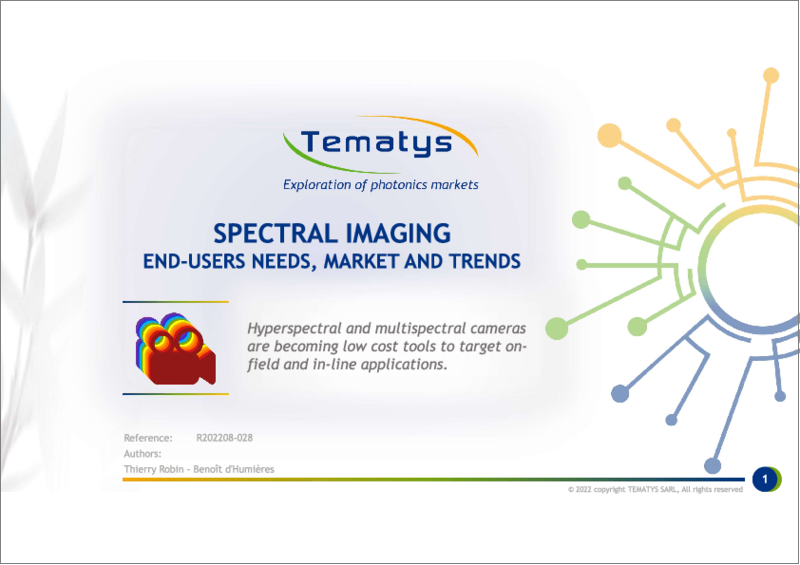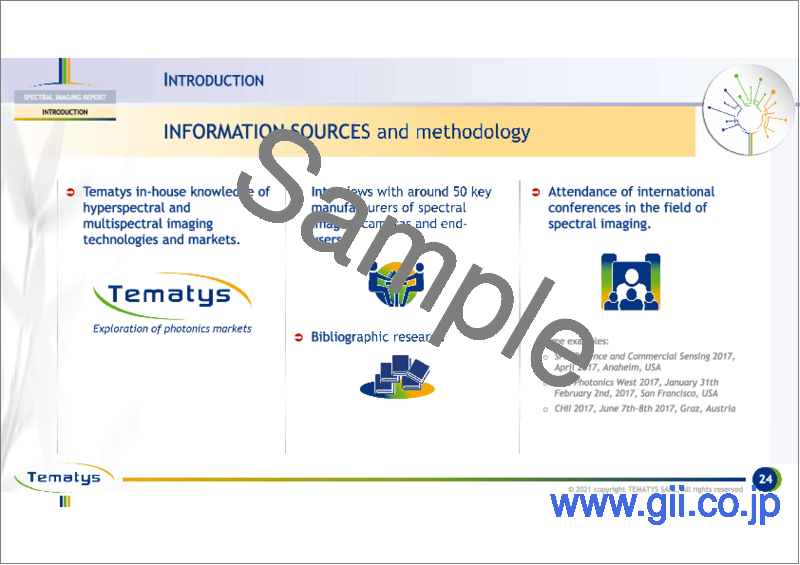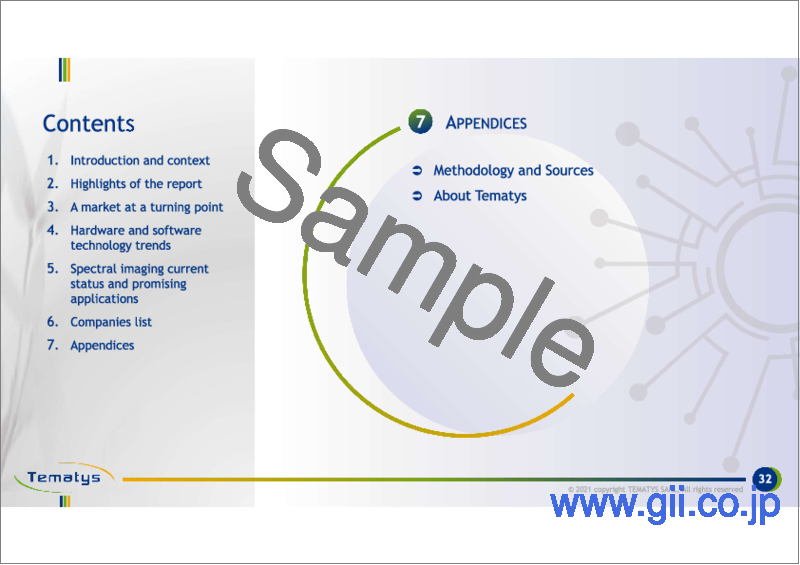|
|
市場調査レポート
商品コード
1127459
スペクトルイメージング:エンドユーザーのニーズ、市場、動向 (2022年) - 現場・インライン用途を目標とした低コストツールと成ったハイパースペクトル・マルチスペクトルカメラSpectral Imaging: End-User Needs, Markets and Trends (2022) - Hyperspectral and Multispectral Cameras are Becoming Lower Cost Tools to Target On-field and In-line Applications |
||||||
| スペクトルイメージング:エンドユーザーのニーズ、市場、動向 (2022年) - 現場・インライン用途を目標とした低コストツールと成ったハイパースペクトル・マルチスペクトルカメラ |
|
出版日: 2022年08月30日
発行: TEMATYS
ページ情報: 英文 204 Slides
納期: 即日から翌営業日
|
- 全表示
- 概要
- 目次
転換期を迎えた市場
人工衛星や飛行機からの地球観測のために導入されたスペクトルイメージング (ハイパースペクトルやマルチスペクトルを含む) は、2000年代に入ってから産業界で選別目的に採用されるようになっています。選別は現在、マルチスペクトルカメラとハイパースペクトルカメラの最大の市場であり、収益も大きいです。
現在、スペクトルイメージング市場はその進化の転換期にあります。1万米ドルを切るコストで、ドローンや産業用ラインに実装できるほどコンパクトなカメラを作るための技術的な取り組みが行われいます。一方、スペクトルデータ解析のための堅牢で使いやすい手法も開発されました。これらの成果により、現場やインラインでのマルチ/ハイパースペクトルカメラの普及が進むと考えられます。スペクトルイメージング市場は、今後数年間で約20%の高いCAGRを記録し、2024年には販売台数が1万台以上に達すると予測されています (宇宙・軍事市場を除く)。
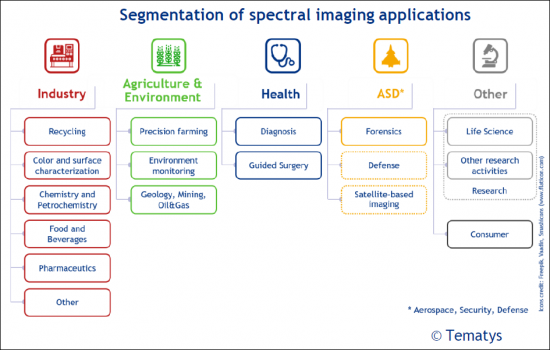
社会的課題を原動力とする市場
空間情報と化学情報を組み合わせることができるスペクトルイメージングは、3種類の主要な産業および社会的な課題に対応しています。
- インダストリー4.0の展開により、複雑な測定を可能にする、費用対効果の高いスマートセンサーへの高い需要が見込まれます。
- 持続可能で安全な食糧生産の必要性:増え続ける人口に高品質の食糧を供給するために、広い面積を高いスループットで測定する必要があります。
- 個別化医療の発展:迅速かつ信頼性の高い診断を可能にする、ラベルフリー・非侵襲・コンパクトなツールの必要性。
このような低コストで高度な分析への要求は、ハイパースペクトルおよびマルチスペクトルカメラの現場およびインライン用途への採用を促進します。高い成長を遂げる市場は、食品・飲料、精密農業、色・表面特性評価、ガス検知、医薬品の品質保証/管理、医療などです。
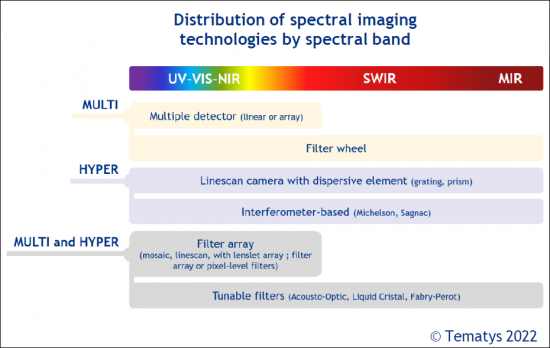
低コストで高度な分析を実現するための技術開発
現場や産業用の活用領域では、低価格で持ち運びができ、使いやすいシステムが求められています。スペクトルカメラのコストとサイズを下げ、データ処理方法を簡素化するために、ハードウェアとソフトウェアのレベルで技術的なブレークスルーが行われています。
最近では、ウエハーレベルでCMOS検出器にフィルターを蒸着する技術や、複数の検出器アレイを統合したカメラの設計など、革新的な技術が利用されています。
これらの技術により、現在、カメラの価格は5,000米ドルから12,000米ドルに達しています。現場や産業界に広く普及させるためには、1,000~5,000米ドルの目標価格を達成するためにさらなる進歩が必要です。
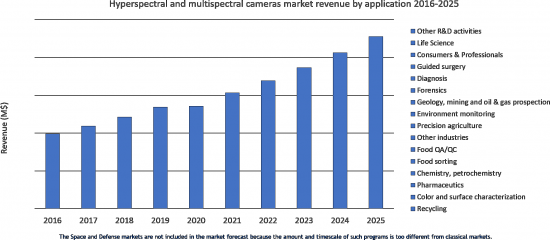
当レポートでは、世界のスペクトルイメージング市場について分析し、市場の最新情勢や基本構造、種類別 (マルチスペクトルカメラ、ハイパースペクトルカメラ) および用途別・スペクトル帯域別の市場規模の動向見通し (台数・金額ベース)、技術の概略と比較、期待される活用領域、今後の市場開拓におけるデータ処理の重要性、エンドユーザー側の要望と対応策、といった情報を取りまとめてお届けいたします。
目次
エグゼクティブサマリー
イントロダクション
分析概略
転換点にある市場
- 促進要因:低コストでの高度な分析の需要
- バリューチェーンと市場の定義
- 市場関係者 (2022年)
- 市場データと予測 (2017年~2025年)
- 市場分析と残された課題
ハードウェア・ソフトウェア技術の動向
- イントロダクション
- 商用技術の内訳
- マルチスペクトルイメージング技術:
- 空間スキャン
- スナップショット
- スペクトルスキャン
- ハイパースペクトルイメージング技術:
- 空間スキャン
- スナップショット
- スペクトルスキャン
- スペクトル帯域ごとのテクノロジーとカメラのコスト
- データ処理レイヤー:アプリケーション指向のソリューションに向けて
スペクトルイメージングの現状と将来有望な活用領域
- 現状
- 対処すべき次の大きな市場
- インダストリー4.0 (色・表面特性評価、製薬)
- 持続可能な食料生産と食の安全 (精密農業、食品選別、食品品質管理)
- 個別化医療 (医療診断、ガイド付き手術)
付録
Hyperspectral and multispectral cameras are becoming low cost tools to target on-field and in-line applications.
Objectives of the report:
- Underline how spectral imaging can address key economical and societal challenges,
- Provide market data and forecast of spectral imaging cameras by application and by spectral band,
- Describe and benchmark the numerous hyperspectral and multispectral available technologies,
- Identify the most promising applications of hyperspectral and multispectral cameras,
- Highlight the importance of data processing in the development of the spectral imaging market,
- Understand end-users requirements for each Application, and the challenges to overcome for a wider adoption of spectral imaging.
Key Features of the report:
- Market revenue breakdown between multispectral and hyperspectral cameras
- Spectral imaging cameras market forecast by applications
- Benchmarking of different spectral imaging technologies
- Analysis of most promising applications
A market at a turning point
First introduced for earth observation from satellites and planes, spectral imaging (including hyperspectral and multispectral imaging) was adopted in industry in the 2000's, for sorting applications. Sorting is currently the biggest market of multispectral and hyperspectral cameras, in revenue.
The adoption in other industrial or in on-field applications remained low for three main reasons: the high cost of cameras, their large size and the huge amount of data to process and store. Currently, the spectral imaging market is at a turning point in its evolution. Technical efforts have been made to build cameras at cost below $10,000 and compact enough to be implemented on drones or in industrial lines. Meanwhile, robust and user-friendly methods for spectral data analysis have been developed. These achievements will lead to a wider adoption of multi/hyperspectral cameras for on-field or in-line applications. The spectral imaging market is expected to experience a high annual growth rate of around 20% in the coming years, reaching more than 10 000 cameras sold in 2024 (excluding the Space and Military markets).
The report provides the breakdown between multispectral and hyperspectral cameras. It also includes detailed market revenue and units forecasts by application and detailed analysis by market segment.

A market driven by societal challenges
With its ability to combine spatial and chemical information, spectral imaging addresses 3 major industrial and societal challenges:
- The deployment of industry 4.0, which induces a high demand for cost-effective smart sensors able to provide complex measurements,
- The need for sustainable and safe food production, which requires measurements on large areas and at high throughput to provide high food quality for an ever growing population,
- The development of personalized healthcare, that implies the need of label-free, non invasive and compact tools, giving a fast and reliable diagnosis.
These demands for low cost advanced analysis will drive the adoption of hyperspectral and multispectral cameras into on-field and in-line applications markets that will experience a high growth are Food & Beverages, Precision Agriculture, Color and Surface Characterization, Gas sensing, Pharmaceutics QA/QC, and Medical applications in the long-term.
In this report, we provide a detailed analysis of current and most promising applications of spectral imaging cameras. We describe the end-users needs and the remaining challenge for their widespread adoption in these markets.

Technology developments meet the demand for low cost advanced analysis
In on-field and industrial applications, the demand for low cost portable and easy-to-use systems is high. Technological breakthroughs are undertaken at hardware and software levels to decrease cost and size of spectral imaging cameras and simplify the data processing methods.
Recent advances take advantage of innovative technologies like deposition of filters on CMOS detectors at wafer level or innovative designs of cameras integrating multiple detector arrays.
With these technologies, cameras currently reach cost of $5 000 to $12 000. Further progresses are necessary to achieve the target price of $1 000 to $5 000 for broad adoption on field or in industry.

Table of Contents
Executive Summary
Introduction
- Study goals and objectives
- Information sources and methodology
- Glossary
- Context and Definitions
- Scope of the report
- List of companies
Highlights of the report
A market at a turning point
- Driver: demand for advanced analysis at lower cost
- Value chain and market definition
- Market players 2022
- Market data and forecasts 2017-2025
- Market analysis and remaining challenges
Hardware and software technology trends
- Introduction
- Segmentation of commercial technologies
- Multispectral imaging technologies:
- Spatial scanning
- Snapshot
- Spectral scanning
- Hyperspectral imaging technologies:
- Spatial scanning
- Snapshot
- Spectral scanning
- Technologies and cameras cost by spectral bands
- Data processing layers: towards application-oriented solutions
Spectral imaging current status and promosing applications
- Current status
- Next big markets to be addressed
- Industry 4.0 (Color and surface characterization, Pharmaceutics)
- Sustainable food production and food safety (Precision farming, food sorting and Food quality control)
- Personalized Health (Medical diagnosis and guided-surgery)
Appendices
- Methodology
- About TEMATYS
